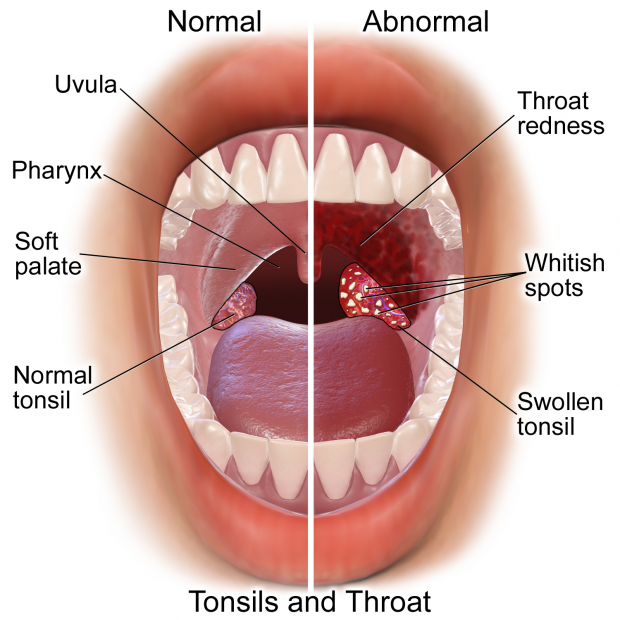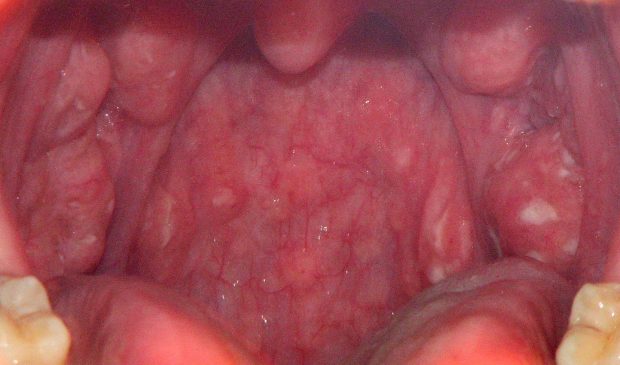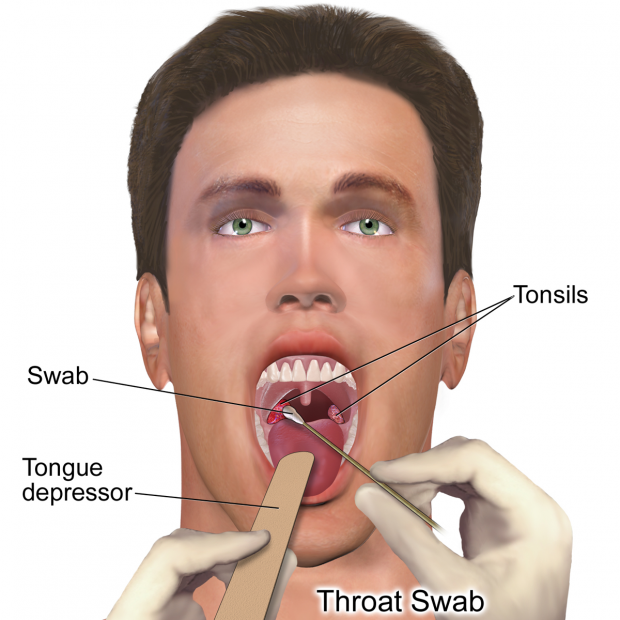Strep throat or more scientifically streptococcus pharyngitis is a bacterial infection. The bacteria streptococcus invades the pharynx or throat and causes an infection in the area. This infection rises to a severe inflammation that is commonly associated with any kind of potential bacterial infection. The infection naturally gives rise to a couple of issues like pain in the throat, scratchiness, and irritation. There is a bad impact on the entire pharynx including the tonsils. Fever is a common symptom of the infection. Other than that, sore tonsil glands and enlarged lymph nodes at the pharynx region are common strep throat symptoms.
Table of Contents
Strep throat causes
The strep throat is caused by the infection from the bacteria streptococcus. The bacteria invades the throat and proliferates there forming a vicious populated colony. This causes the infection, subsequent inflammation. The bacteria enter into the pharynx via the respiratory tract. The Group A beta hemolytic streptococcus is the true culprit for this disease.
Spread of infection
The bacterias can enter the respiratory tract of a healthy person via the respiratory droplets from an infected person. It can also spread by coming in contact to any skin area that is infected with streptococcus. The respiratory droplets or any kind of body fluids from an infected person is the main carrier of this disease. This is an airborne disease. On close and direct contact with the infected person, this disease spreads rapidly.
The probability of being knocked down by the bacteria increases in crowds or gatherings. Sitting beside an infected person in schools, workplace or while travelling through public transport are potent instances of infection. The bacteria in the dry form does not cause much infections. It is dreaded in the moist form. Spread of disease-causing bacteria can also occur through contaminated food and water.

Who are affected?
The age group that is most vulnerable to the strep throat symptom is the group between 5 to 15 years of age. The kids are not equipped with a very strong immunity system; hence they are more prone to infection. Adults can also be down with the infection specially accompanied by fever.
The time of the year when the risk of infection is maximum is the early spring and winter seasons. During this time, the bacterias grow and proliferate more rapidly.
Strep throat symptoms
Following are the most common symptoms that accompanies a streptococcal pharyngitis: –
- Pain in the throat is the most initial symptom that is indicative of sore throat. Along with pain, there is a scratchiness and feeling of irritation in the throat.
- Not only the throat, one can feel the pain in the tonsil glands and the lymph glands in vicinity to the pharynx
- At the back of the mouth palate, red colored dots appear. These dots indicate bacterial infection. There may be appearance of white patchy infectious areas at these areas in some individuals. These also indicate infection
- A person who is affected by strep throats also feels pain while swallowing any type of food. Pain may be felt while breathing too.
- The tonsil glands also swell up. You will have an extreme sensation of pain in the tonsil glands. At times, the infection becomes drastic and streaks of white pus appears at site of infection.
- The lymph glands proximal to the throat and neck becomes red, swelled and infected.
- for a long period
- Young children also feel nausea,
- High fever
- Extreme headache lasting vomiting
- Rashes also appear
Now, there are two uncertainties that might occur.
Firstly, there might be symptoms but you might not be a victim of strep throat
Secondly, you might be a victim but the infection might be devoid of any of these symptoms.
That is why, it is extremely important to visit a doctor if the above-mentioned symptoms continue for more than 48 hours. The physician will usually prescribe for diagnostic tests specific for strep throat.
How will you know if it is strep throat?
The common strep throat symptoms and those of common cold are almost parallel. But let us watch out for the distinguishable symptoms of strep throat that will give you a clue, that it is not mere cough and cold, but more severe than that
- The throat infections that come in hand with common cold is painful but not unbearably. The pain in case of strep throat is extreme. The pain might be so drastic that you won’t be able to breathe even
- Due to the unbelievable pain that the victim feels while swallowing, he or she might lose appetite and fall sick due to lack of food
- Red rashes all over your body or across the neck and throat might indicate that you have a strep throat
- Continued high temperatures above 101-degree Fahrenheit for 48 hours or more along with throat pain is a good clue for strep throat.

Associated disorders of strep throat
Streptococcus infection that is the main cause of strep throat, is highly contagious. It does not remain restricted to only the throat. The infection also spreads to a number of other body parts the most common ones being middle ear, skin and blood sinuses.
The disorders which accompany strep throat may appear either during the infection or post infection. They are: –
- Scarlet fever: – it occurs during the streptococcal infection. The characteristics of this fever are sustained high temperatures and red rashes all over the body
- Rheumatic fever: – when a streptococcal infection occurs in the body, it may spread to the joints and cartilages even. This infection causes subsequent swelling and pain in the joints. The infection is also accompanied by high and prolonged fever
- Post streptococcal glomerulonephritis: – After the visible effects of the strep infection get cured, there might occur pathophysiological conditions such as these. In this disorder the glomerulus of the kidneys become inflamed due to the attack of streptococcus. This causes impairment of normal kidney functions
- Poststreptococcal arthritis: – The streptococcal infection leaves atrial behind in terms of swelling and arthritic pain in joints all across the body. this causes the post streptococcal arthritis. The disorder causes considerable hindrance in movement and locomotion.
Diagnosis of strep throat
When you approach a physician with the strep throat symptoms, he or she is likely to physically examine the throat and take a record of the symptoms. If the symptoms indicate towards strep throat, then a diagnostic test will be conducted
Rapid antigen test
Initially a sample of swab from your throat region will be collected. The presence of antigens, in this sample will be tested. The presence of streptococcus antigens if found the result of the test will be declared as positive and vice versa. This takes only a few minutes. Statistics say that this test is more than 90 percent reliable. The results can be prepared in just around 20 to 30 minutes. The benefits of this test are that it is very fast and easy to perform. Moreover, the results are convincing. The test is painless which makes it convincing to perform. This test follows the principle of immunosorbent assay
At times it so happens that the patient has prominent symptoms of strep throat but the results of this test comes negative. Sometimes, the population distribution of streptococcus may spread unevenly in the throat. When the swab sample for rapid antigen test is taken, the number of streptococci that gets attached to the swab might be less and hence remain undetected in the test. At that time, the physician normally suggests for the next tier of diagnostic test.
Throat culture test
A swab is rubbed against the back of the throat for collection of the sample. The sample that is collected is cultured in the laboratory. After a culture is prepared, the samples are re tested. If there is streptococcus in the sample, then in those few days, they will develop a considerable colony of population that will be easily detected. This test is much more reliable than the rapid antigen test. The only drawback is that time taken to confirm results is more than the former test. It is more reliable because even if any trace of bacteria is present in the secretions collected from the throat or tonsil glands, the doctor can easily detect it.

Medication for strep throat
When the strep throat symptoms have been backed by scientific evidences from clinical laboratory test results, it is time for medications. As a general rule of pharmacology, you need antibiotics to kill the bacterial population. The doctors generally prescribe oral antibiotics. If the patient takes the antibiotics within 48 hours of infection, then there can be numerous benefits
- The spread of the infection can reduce
- The pain and irritation caused from the infection reduces
- Bring down the level of contagiousness of the disease.
Within a day of taking antibiotics, the patient feels relief. It is important to complete the course of the medicines otherwise infection has a tendency of recurring.
IBrufen (commercial name Advil, Montrin) and acetaminophen (Tylenol) are the two pharmacological substances that are generally used to diminish the immediate issues. These bring down the intensity of extreme pain and irritation. Hence, these are immediate relievers of strep throat symptoms.
Amoxicillin, Cephalexin, penicillin are three common strep throat antibiotics. These will prevent the onset of the subsequent complications of strep throats. The antibiotics will also shorten the span of infection.
Aspirin might seem to be a symptom reliever in this case. Aspirin has the potential to reduce the headache or bring down the pain too. But it is highly advisable to avoid the usage of aspirin tablets, especially in young children. It causes many hilarious side effects.
Strep throat remedies
Once you notice the strep throat symptoms, before the onset of medications, there are some immediate home remedies that one can follow. One can carry these out parallelly with medications. The home remedies provide instantaneous relief and soothe the pain to a large extent. Few of the effective home remedies are: –
- During this infection, the throat dries up a lot. The dehydration fosters infection and amplifies the irritability and discomfort. The patient must drink plenty of water to prevent this dehydration. To keep the mucous membranes moist, one can use simple saline nasal sprays. Air humidifiers may help in case of extreme infection
- Usually, the patient loses the will to eat because he or she faces extreme pain to swallow food. If the patient eats non-spicy and soft food, then there will be less of irritation. Liquid food is easy to swallow as well as soothing for the throat.
- Gargling with lukewarm water and salt at least three times a day helps a lot. It relieves the throat pain. The only thing that one should keep in mind is, one has to throw out the water after gargling and not swallow it. The gargled water will contain bacterias and on swallowing it will enter the esophagus causing the spread of infection
- Proper sleep will help to boost the immunity of the body. Rest can improve the ability of the body to cope with the infection. Hence, sleep and rest are must during strep throat infections.
Prevention is better than cure
Always cover your nose while sneezing. Whenever you are around a lot of people try to cover your mouth. Remember, it is the respiratory droplets from infectious persons that cause this disease.
In your house, if anybody is down with strep throat then avoid close contact with him or her. Also wash your hands properly after touching the common items like tv remote, doorknobs and so on. Try and avoid taking food at any unhygienic place.
It is not completely possible to stop the occurrence of streptococcus infections. But proper preventive measures can help reduce the chances. Other than that, one should pay proper heed to the strep throat symptoms. It is extremely dangerous to keep the symptoms unattended. Early diagnosis and timely treatment can reduce the extent of the infection








